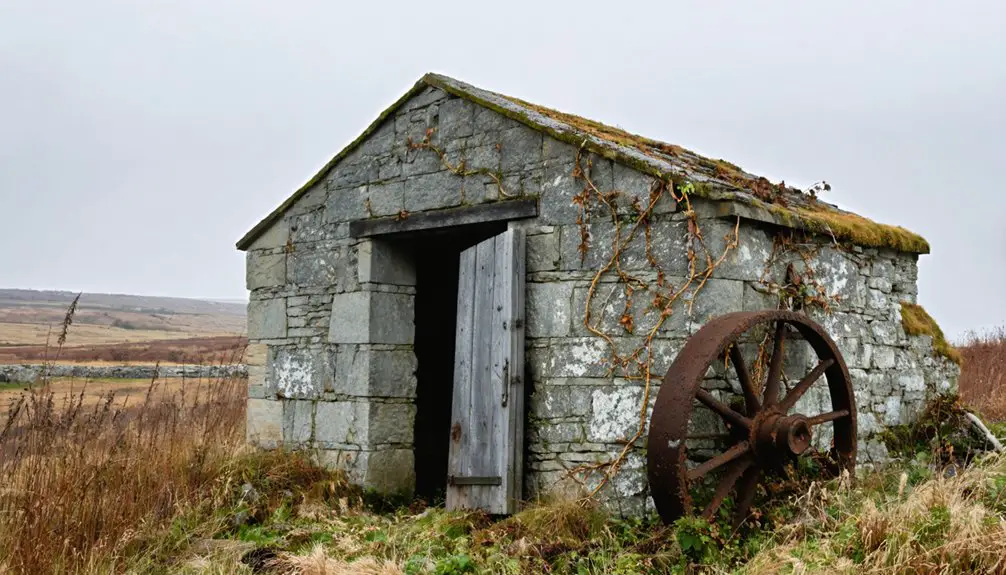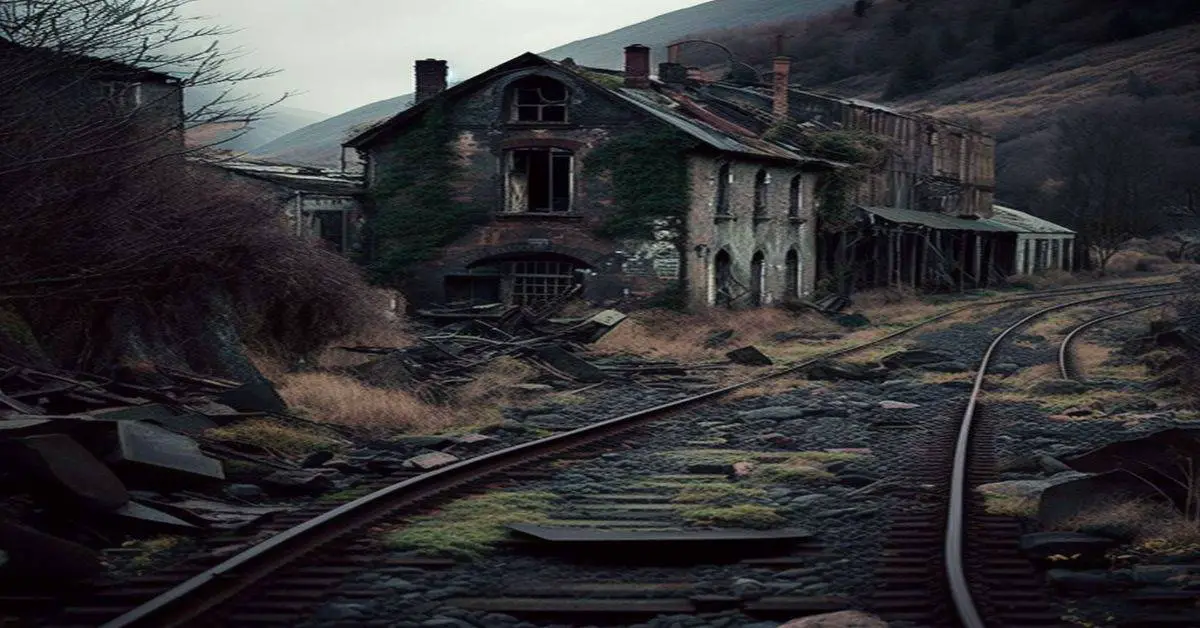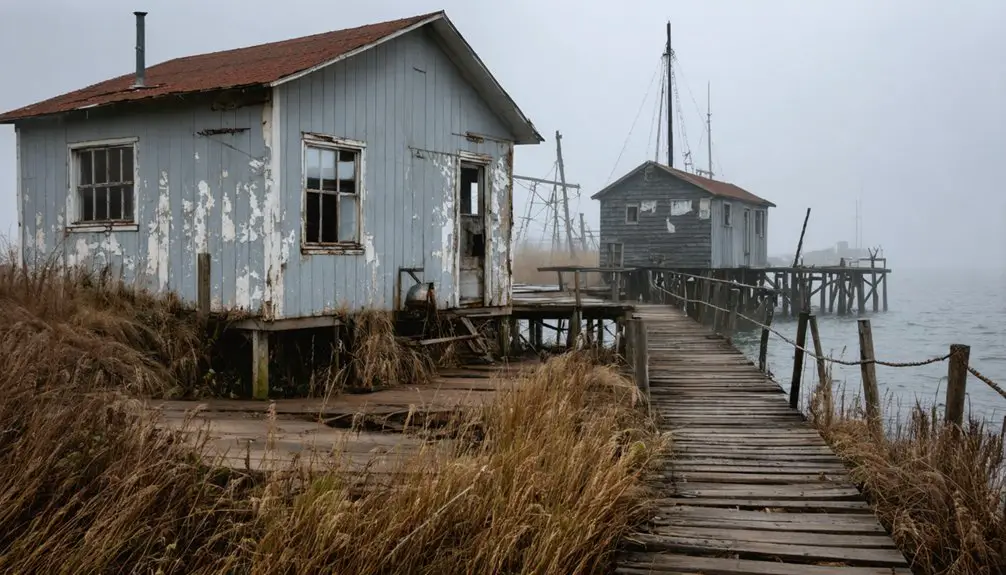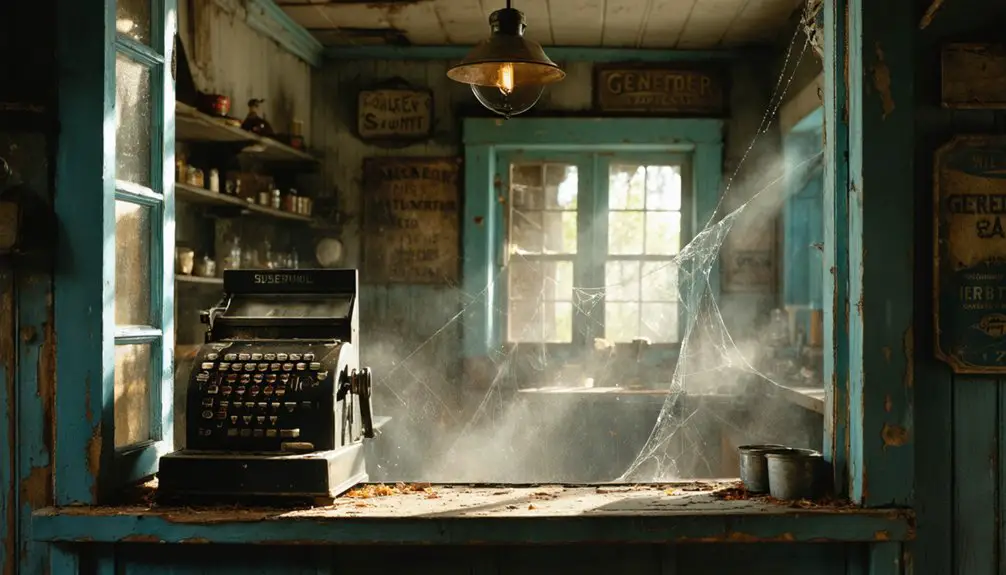You’ll find Pendarvis isn’t actually a ghost town, but rather a preserved Cornish mining settlement in Mineral Point, Wisconsin. The site features authentic limestone cottages and restored buildings from the 1830s lead mining era. Two preservationists, Bob Neal and Edgar Hellum, saved these structures in the 1930s, transforming them into a living history museum. The site’s carefully maintained architecture and artifacts offer fascinating insights into Wisconsin’s frontier mining heritage.
Key Takeaways
- Pendarvis is not a ghost town but a preserved historic site in Mineral Point, Wisconsin showcasing 1830s Cornish mining settlement architecture.
- Bob Neal and Edgar Hellum saved the site from becoming abandoned by restoring multiple stone buildings in the 1930s.
- The site features six restored historic cabins that demonstrate early Cornish immigrant life during Wisconsin’s mining era.
- Pendarvis House operated as a successful restaurant serving Cornish cuisine, helping maintain the site’s vitality through tourism.
- The Wisconsin Historical Society now operates Pendarvis as a living museum with seasonal guided tours from May to October.
The Cornish Mining Settlement’s Origins
While the decline of Cornwall’s tin mines drove experienced miners to seek new opportunities abroad, southwestern Wisconsin’s lead-rich region became their promising destination in the 1830s.
You’ll find that these Cornish settlers were drawn to Mineral Point’s familiar geological features, particularly its light-colored galena limestone that reminded them of their homeland. They used this abundant stone to construct sturdy stone homes that still stand today.
Though Native American tribes like the Ho-Chunk had long mined the area’s lead deposits, the arrival of Cornish immigrants brought advanced mining techniques that transformed the region. This transformation helped establish Mineral Point as a major land office for the territory.
Cornish immigrants revolutionized lead mining in Wisconsin, building upon centuries of Native American mining traditions with their advanced methods.
Despite initially settling illegally on protected Native lands, treaties in the early 1830s legitimized their presence.
The Cornish heritage quickly took root as hundreds of miners established themselves, turning Mineral Point into a thriving commercial center and early territorial seat in Michigan Territory.
Architectural Legacy in Stone and Timber
Three key architectural elements define Pendarvis’s enduring Cornish heritage: locally quarried limestone walls up to 20 inches thick, traditional timber framing, and simple yet functional designs that mirror mid-19th century working-class homes.
You’ll find masterful stone masonry throughout the settlement, particularly in the rowhouse complex of three adjacent buildings constructed between 1841 and 1852.
The Polperro house showcases the distinctive blend of stone first stories with timber upper floors, while Trelawny exemplifies multi-story stone cottage craftsmanship. The first floor was transformed into an antique shop and museum that celebrated the area’s mining history.
Bob Neal and Edgar Hellum’s careful restoration preserved these authentic features, often removing later additions to reveal original stonework. Their efforts maintained the structural integrity while adapting spaces like the Pendarvis House into a restaurant, ensuring these architectural treasures continue telling the story of Wisconsin’s Cornish mining heritage.
Visitors can explore these historic structures through seasonal guided tours offered by the Wisconsin Historical Society, providing intimate access to this remarkable architectural legacy.
Neal and Hellum’s Historic Preservation
During the 1920s and 1930s, as Mineral Point’s historic Cornish mining cabins faced imminent demolition, Robert Neal and Edgar Hellum set out on a pioneering preservation mission that would transform the town’s architectural heritage.
Their innovative preservation techniques included restoring thick limestone walls and maintaining authentic period details while assigning traditional Cornish names to each building they saved. The partners began in 1934 with their first project, removing old floors and replacing deteriorated joists.
You’ll find their most significant achievement in converting Pendarvis House into a renowned restaurant serving Cornish cuisine. This creative approach generated funds for additional restorations while celebrating the cultural significance of Wisconsin’s mining heritage. Today, visitors can explore this remarkable site from late May to October and experience the rich history firsthand.
As life and business partners, Neal and Hellum’s dedication resulted in the preservation of six historic cabins, including the distinctive Trelawny and Polperro structures, which continue to educate visitors about early immigrant life and regional history.
From Mining Town to Culinary Destination
As Pendarvis House evolved from a simple tea room into a renowned culinary destination, it pioneered a unique fusion of Wisconsin’s mining heritage with regional gastronomy.
You’ll discover a dining experience that transports you through time, featuring traditional Cornish dishes like pasties alongside modern interpretations of miners’ fare. The restaurant attracted notable culinary figures like author Marjorie Kinnan Rawlings who helped spread its reputation. Local favorites such as Red Rooster Cafe continue this tradition of serving authentic Cornish specialties today.
The restaurant’s 1940s decor and stone terraces create an immersive historical atmosphere while you savor artisanal, locally-sourced ingredients.
You’re experiencing more than just a meal – you’re participating in culinary heritage preservation. The menu adapts traditional recipes for contemporary tastes while honoring original cooking methods and ingredients.
Through seasonal offerings and special events, you’ll connect with the rich cultural legacy of Wisconsin’s mining era, as storytelling and gastronomy combine to illuminate the immigrant experience and communal aspects of miner life.
A Living Museum of Wisconsin’s Mining Era
The restoration of Pendarvis stands as a tribute to Wisconsin’s rich mining heritage, thanks to the dedicated efforts of Robert Neal and Edgar Hellum in the mid-20th century.
Open from May to October, the preserved site welcomes visitors seeking to explore this unique piece of Wisconsin history.
You’ll find authentic artifacts, mining tools, and household items that bring the lead mining era to life within the preserved limestone cottages that now serve as a living museum.
When you explore the site, you’ll discover how Cornish immigrants shaped the cultural heritage of southwestern Wisconsin.
The museum illuminates the evolution from lead to zinc mining while preserving traditional architectural methods.
You can walk the trails of Merry Christmas Mine Hill, where visible mining remnants blend with restored prairie landscapes.
Through guided tours and educational programs, you’ll experience firsthand how these early settlers, known as “badgers,” transformed Mineral Point into a thriving mining center.
Frequently Asked Questions
Are There Any Reported Ghost Sightings or Paranormal Activities at Pendarvis?
You’d think a historic mining settlement would be teeming with ghost stories, but you won’t find documented paranormal evidence at Pendarvis – it’s strictly preserved for its cultural heritage, not supernatural claims.
What Happened to the Original Mining Equipment and Tools?
You’ll find the original mining equipment preserved as museum artifacts, with tools displayed inside restored buildings and some remnants visible on Merry Christmas Mine Hill, protecting this essential mining heritage.
How Many People Lived in Pendarvis During Its Peak Mining Years?
Like a pulse in the mining heartbeat, you’ll find population trends suggest hundreds of residents lived there during peak years, with mining demographics showing Cornish immigrants comprising roughly half the community.
Can Visitors Still Sample Authentic Cornish Recipes at the Site Today?
You can’t currently sample authentic Cornish cuisine or historical recipes at the site, though you’ll learn about these culinary traditions through educational exhibits and interpretive programs at the preserved location.
What Mining Techniques Did the Cornish Immigrants Use to Extract Lead?
Sharp as pickaxes, Cornish miners brought their expertise in deep shaft digging, using water pumps, blasting powder, and hard-rock mining techniques. You’ll find they adapted Cornwall’s lead extraction methods to Wisconsin’s terrain.
References
- https://lakecountrytribune.com/exploring-the-haunting-echoes-of-wisconsins-ghost-towns/
- https://en.wikipedia.org/wiki/Pendarvis_(Mineral_Point
- https://pendarvis.wisconsinhistory.org/explore/history-of-pendarvis/
- https://sitesandstories.wordpress.com/category/historic-sites/pendarvis/
- https://pendarvis.wisconsinhistory.org
- https://www.americanheritage.com/content/pendarvis-house
- https://www.portalwisconsin.org/archives/pendarvis_feature.cfm
- https://www.southwestwi.com/pendarvis/
- https://pendarvis.wisconsinhistory.org/explore/
- https://sitesandstories.wordpress.com/tag/pendarvis/



